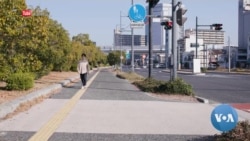ສຳລັບຄົນຕາບອດ ແລະຜູ້ພິການທາງສາຍຕາແລ້ວ ການໄປທາງໃດມາທາງໃດມັກຈະໝາຍເຖິງການໃຊ້ໝານຳທາງ ຫຼື ໄມ້ເຂ່ຍ ໃນຍາມຍ່າງສະເໝີ. ແຕ່ໃນປະເທດ ຍີ່ປຸ່ນນັ້ນ ມີຂໍ້ຄິດທີ່ເປັນປະໂຫຍດຢູ່ໃຕ້ພື້ນຕີນຂອງເຂົາເຈົ້າ - ຊຶ່ງເປັນຊ່ອງໂຕໜັງສືນູນ ຫລື ບາເຣລ (Braille).
ທ່ານຣອຍເຮ ໂຕກຸດະ (Ryohei Tokuda) ຜູ້ອໍານວຍການດ້ານການພັດທະນາຂອງ ບໍລິສັດອາຊີຣາເຊ (Ashirase) ກ່າວວ່າ: "ມັນເປັນທີ່ນິຍົມກັນໃນປະເທດຍີ່ປຸ່ນ, ສະນັ້ນມັນມີຢູ່ທົ່ວທຸກຫົນທຸກແຫ່ງ, ຢູ່ຕາມຖະໜົນຫົນທາງ, ໃນປະເທດຍີ່ປຸ່ນ."
ພື້ນຜິວປູຢາງ ທີ່ຮັບຮູ້ດ້ວຍການສຳຜັດເຫຼົ່ານີ້ ໄດ້ແຜ່ລາມໄປທົ່ວໂລກ, ໂດຍໄດ້ນໍາ ທາງຜູ້ໃຊ້ໂດຍຕົວຊີ້ບອກທາງຮ່າງກາຍ ທີ່ເຂົາເຈົ້າສາມາດຮູ້ສຶກໄດ້.
ບໍລິສັດອາຊີຣາເຊ (Ashirase) ທີ່ເປັນບໍລິສັດເລີ້ມຕົ້ນໃຫມ່ຂອງຍີ່ປຸ່ນ ກໍາລັງເອົາ ແນວຄວາມຄິດນີ້ ກ້າວຂຶ້ນໄປອີກບາດກ້າວນຶ່ງ ໂດຍເອົາຄວາມຮູ້ສຶກຢູ່ພາຍນອກ ເຂົ້າໄປໃນຫັ້ນ.
ທ່ານໂຕກຸດະ (Tokuda) ກ່າວອີກວ່າ: “ຈະເຮັດໃຫ້ເກີດການຮັບຮູ້ຊ່ອງຕົວອັກສອນນູນ ຢູ່ໃນເກີບນັ້ນໄດ້ແນວໃດ? ນີ້ແມ່ນຈຸດທໍາອິດຂອງພວກເຮົາ.”
ອຸປະກອນອາຊີຣາເຊ (Ashirase) ທີ່ເປັນລະບົບນໍາທາງໃນເກີບ ໄດ້ຊີ້ທາງໄປແກ່ ຜູ້ໃຊ້ດ້ວຍຄວາມສັ່ນສະເທືອນ…… ແລະເຊັນເຊີການເຄື່ອນໄຫວ ທີ່ວາງໄວ້ຢູ່ພາຍໃນເກີບຂອງເຂົາເຈົ້າ.
ທ່ານໂຕກຸດະ (Tokuda) ອະທິບາຍວ່າ: "ມີເຄື່ອງສັ່ນສະເທືອນໃນສາມຈຸດ ທີ່ຢູ່ໃນອຸປະກອນອັນດຽວກັນ, ແລະທ່ານຈໍາເປັນ ຕ້ອງໃຊ້ອຸປະກອນທັງສອງອັນ ຢູ່ໃນເກີບທັງສອງກິ່ງ."
ໂດຍທີ່ມີອຸປະກອນອັດສະລິຍະ ທີ່ເຊື່ອມຕໍ່ກັບແອັບພິເຄຊັນຜ່ານບລູທູດ (Bluetooth) ຜູ້ໃຊ້ຈະເອົາທີ່ຢູ່ຂອງຈຸດໝາຍປາຍທາງຂອງເຂົາເຈົ້າໃສ່ໃນຫັ້ນ ແລະເສັ້ນທາງກໍ ຈະ ຖືກວາງເປັນແຜນທີ່ອອກມາ.
ເຊັນເຊີຈັບການເຄື່ອນໄຫວຈະກວດຫາທິດທາງທີ່ຜູ້ໃຊ້ກຳລັງມຸ້ງໜ້າໄປຫາ ແລະ ຄວາມສັ່ນສະເທືອນ ຢູ່ທາງຕີນຊ້າຍ ຫຼື ຕີນຂວາ, ຊີ້ບອກວ່າຈະໄປທາງໃດ. ຄວາມໄວຂອງການສັ່ນສະເທືອນກໍມີຫລາຍລະດັບແຕກຕ່າງກັນອີກ.
ທ່ານໂຕກຸດະ (Tokuda) ເວົ້າອີກວ່າ: “ຈັງຫວະຄວາມໄວຂອງການສັ່ນສະເທືອນ ແມ່ນກົງກັນກັບໄລຍະຫ່າງໄປຫາຫົວມຸມຫົນທາງ. ເມື່ອຜູ້ໃຊ້ເຂົ້າໄປໃກ້ຫົວມຸມຫົນທາງ ຈັງຫວັດການສັ່ນສະເທືອນ ຈະເພີ່ມ ຂຶ້ນ.”
ພວກພັດທະນາອຸປະກອນກ່າວວ່າ ສິ່ງຊີ້ບອກເຫຼົ່ານີ້ອະນຸຍາດໃຫ້ຜູ້ໃຊ້ທີ່ຕາບອດແລະ ພິການທາງສາຍຕາ ສຸມໃສ່ການລວບລວມເອົາຂໍ້ມູນທີ່ສໍາຄັນອັນອື່ນ ກ່ຽວກັບ ສິ່ງທີ່ຢູ່ອ້ອມຂ້າງຂອງເຂົາເຈົ້າໄດ້.
ພວກເຂົາເຈົ້າເວົ້າກັບບໍລິສັດອາຊີຣາເຊວ່າການໃຫ້ທິດທາງແມ່ນສິ່ງນຶ່ງທີ່ຈະເຮັດໃຫ້ເປັນຫ່ວງໜ້ອຍລົງ.
ທ່ານໂຕກຸດະ ກ່າວມ້ວນທ້າຍວ່າ: "ອຸປະກອນອາຊີຣາເຊ ສາມາດໄປຕາມເສັ້ນທາງ, ສະນັ້ນ ເຂົາເຈົ້າສາມາດສຸມໃສ່ ຄວາມປອດໄພໄດ້."
ມັນເປັນວິໄສທັດເພື່ອໃຫ້ມີອິດສະລະພາບ ແລະການເພິ່ງຕົນເອງໄດ້ຫຼາຍຂຶ້ນກວ່າເກົ່າ.
ອ່ານຂ່າວນີ້ເພີ້ມເປັນພາສາອັງກິດຢູ່ລຸ່ມນີ້:
Blind and visually impaired people often rely on walking sticks and guide dogs to help them navigate streets and sidewalks, but one Japanese startup is bringing navigation technology directly to their shoes.
For the blind and visually impaired, getting around often means using a guide dog or walking stick. But in Japan, there are helpful clues right beneath your feet -- Braille blocks.
Ryohei Tokuda, Ashirase Director of Development:
“It is famous in Japan, so they are everywhere, in road, in Japan.”
These tactile pavement surfaces have spread across the world, guiding users with physical cues they can feel.
Japanese startup Ashirase is taking the idea a step further, bringing the external sensations in.
Ryohei Tokuda, Ashirase Director of Development: “How do realize braille block inside the shoe? This is our first point.”
The Ashirase, in-shoe navigation system guides users with vibrations…… and motion sensors placed inside their shoes.
Ryohei Tokuda, Ashirase Director of Development: “There are three area vibrator inside the one device, and you need to use both devices on both shoe.”
With the smart devices connected to an app via Bluetooth users enter their destination and a route is mapped out.
Motion sensors detect the direction a user is heading in and vibrate on either the left or right foot, indicating which way to go. The speed of vibrations also varies.
Ryohei Tokuda, Ashirase Director of Development: “The tempo of vibration is corresponding to the distance to the corner. When user approach to the corner tempo vibration increases.”
The developers say these cues allow blind and visually impaired users to focus on gathering other important information about their surroundings.
They say with Ashirase, directions are one less thing to worry about.
Ryohei Tokuda, Ashirase Director of Development: “Ashirase can follow the route, so they can focus on the safety.”
It’s a vision for more freedom and autonomy.





